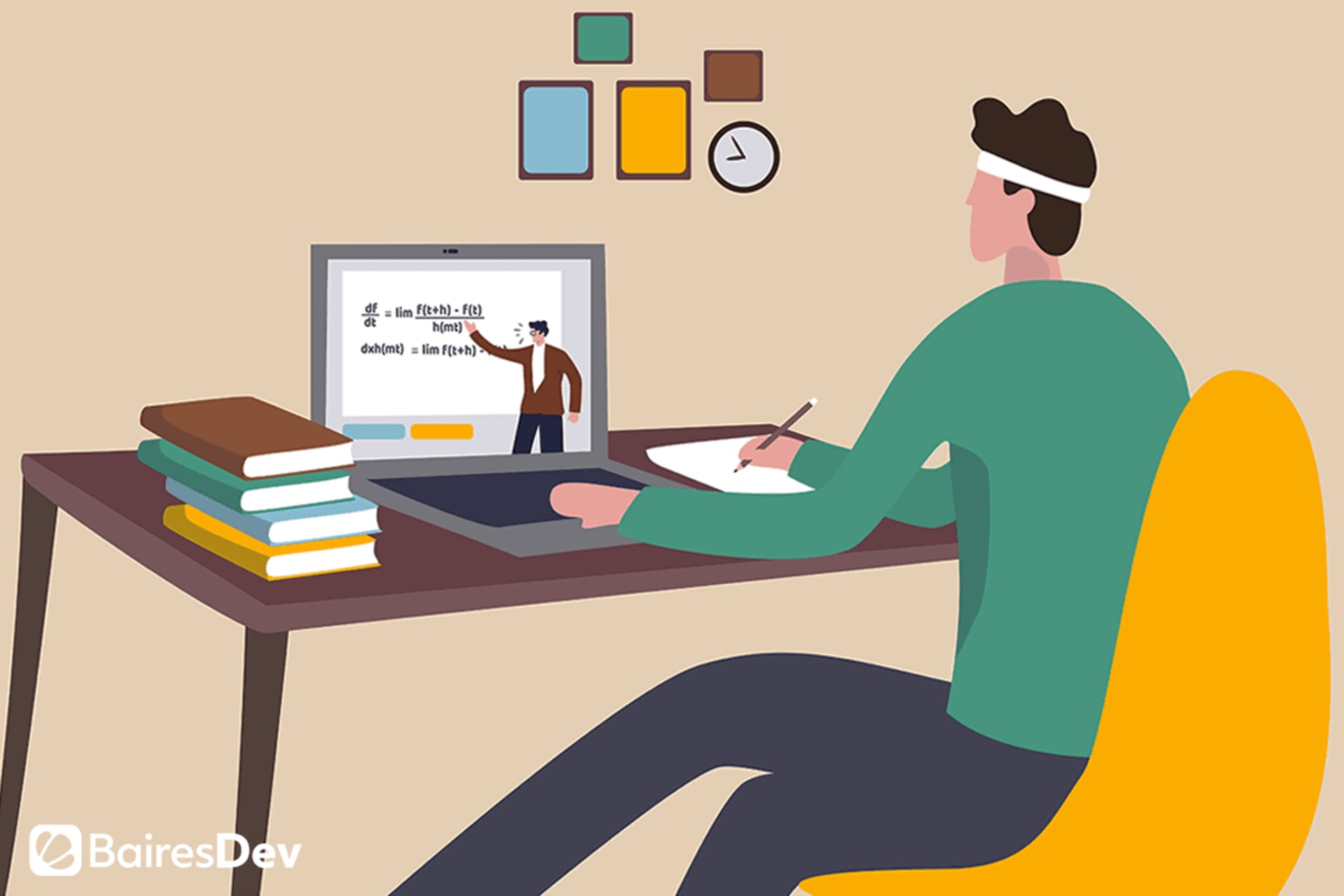- Home
- Industries
- eLearning
Elearning Software Development
Build custom eLearning solutions that engage students and elevate the learning process.
500+ companies rely on our top 1% tech talent.
eLearning development services we provide
eLearning Platform Development
Enhance educational experiences with our eLearning platform development services. We create customized platforms that optimize educational content, boost student engagement, and streamline administrative processes, bettering the overall learning journey for both students and educational institutions alike.
Mobile Learning App Development
Empower learners on the go—or create increased opportunities for educators to share content—with our mobile learning app development. Our mobile apps can be customized to your needs—whether that’s educational content, interactive features, real-time student-educator collaboration, or something else. We build scalable, flexible, and engaging learning apps for students to use anytime, anywhere.
Custom Courseware Creation
Level up your educational content with our custom courseware creation services. We design engaging and personalized course materials for specific learning objectives and demographics of learners. Our courses help make for a more effective and impactful educational environment.
Learning Management System (LMS) Integration & Customization
Optimize educational management with our learning management system (LMS) integration and customization. We integrate robust learning management systems, tailoring them to meet the various needs of educational institutions. These systems improve content delivery and track student progress.
Virtual Classroom Solutions
Transform traditional classrooms into dynamic virtual classrooms to connect students and educators from anywhere in the world. Our services provide a platform for real-time and interactive learning. They bring an engaging and immersive educational experience to students and educators in all corners of the globe.
Educational Game Development
Combine education and entertainment with our educational game development services. We create gamified, interactive experiences that facilitate learning. The goal is to make educational content more enjoyable and, therefore, memorable for students across many different subjects.
Analytics & Reporting Tools
Gain valuable insights about courses, student performance, and educational trends with our analytics and reporting tools. We provide solutions that assess learning effectiveness, track student progress, and offer data-driven insights for educators to refine teaching methods and improve students’ results.
Cloud-Based Learning Solutions
Cloud-based learning solutions enable institutions to store, access, and deliver educational content securely through the cloud. This ensures the scalability and accessibility of learning materials, which ultimately boosts collaboration among educators, as well.
Types of custom eLearning software we can help with
Adaptive Learning Platforms
Adaptive learning platforms dynamically adjust content delivery to individual learner needs, enhancing engagement and knowledge retention. This ensures a personalized and efficient learning experience for students of all ages and disciplines.
AI-Powered Course Recommendations
Training curricula with AI-powered course recommendations leads to a better learning experience. AI can analyze learner preferences and educational trends, adapting course suggestions to individual needs and market demands. This ensures that students receive targeted and relevant content, fostering continuous learning and skill development.
Virtual Reality Training Simulators
Immerse your educational staff or students in realistic training scenarios with virtual reality training simulators. Our custom solutions provide hands-on experiences, enhancing skill development for educators and students alike. This innovative approach ensures practical and effective training in a virtual environment, so anyone can join from anywhere.
Machine Learning-Enhanced Analytics Tools
Harness the power of machine learning with analytics tools. Tailored for the education sector, these tools analyze data, providing valuable insights into learner performance, engagement, and areas for improvement. The end result is boosted effectiveness and optimized learning experiences.
Blockchain-Based Certification Systems
Ensure the authenticity of certifications with blockchain-based certification systems. These systems secure and verify educator credentials, providing a transparent and tamper-proof certification process. This adds credibility to your educational platform, fostering trust among students who know that they’re learning from accredited professionals.
Interactive 3D Learning Environments
Overhaul training with interactive 3D learning environments. Tailored for the education sector, these environments engage learners through immersive experiences, creating a fun and dynamic training atmosphere that has the potential to improve knowledge retention and skill development.
Gamified Learning Experiences
Gamified learning experiences infuse elements of game design into training modules. This helps to motivate students to accomplish personal goals, overcome challenges, and reap rewards for their hard work. Gamified learning is enjoyable and proven to be effective.
Cloud-Based Collaborative Learning Platforms
Facilitate collaborative learning with cloud-based platforms that enable students to access educational materials, work with educators in real-time, and engage in group activities. This fosters teamwork among other students and creates space for knowledge sharing within a cloud-based environment. These cloud-based solutions can also improve collaboration among educators within an institution.
Data-Driven Student Engagement Tools
Data-driven student engagement tools analyze learner interactions with your educational platform. From there, they provide insights so educators can optimize training content—how it’s structured, delivered, and everything in between.
Personalized Learning Pathways
Personalized learning pathways create adaptive learning journeys, tailoring content and assessments to each learner's pace and preferences. This ensures a personalized and efficient training experience for students of all backgrounds and ages in any subject field.
Social Learning Networks
Social learning networks connect students with their peers and educators, allowing them to share knowledge, collaborate on educational projects, and engage in continuous learning. These networks help to establish supportive networks, making education more accessible for everyone.
Other Applications
Explore additional possibilities for custom software applications for eLearning, including content-management systems for educational content, educational event planning tools, and employee-performance tracking systems tailored to the unique needs of the education industry.
Benefits of building bespoke solutions
1. Competitive Edge
Choosing custom eLearning software provides you with a distinct competitive edge. Customized solutions can better align with your business needs and educational offerings with features that set you apart in the dynamic eLearning landscape. They also help to foster innovation for standout educational experiences.
2. Efficiency and Productivity
Investing in custom eLearning software streamlines operational processes—enhancing efficiency and productivity for educators. These solutions address workflows and specific challenges, allowing educators and administrators to instead focus on delivering high-quality educational content and improving learning experiences for students.
3. Longevity and Adaptability
Custom eLearning software ensures longevity and adaptability in the ever-evolving educational landscape, which is constantly adapting to emerging technologies and changing industry regulations. By tailoring solutions, you become better able to adapt to future changes, advancements, and trends, ensuring sustained relevance and effectiveness.
4. Improved Learner Experience
Enhance the overall educational experience for both educators and students with custom eLearning software. By addressing distinct needs and personal preferences, customized software improves engagement, satisfaction, and the overall learner experience. It creates a positive learning environment that keeps individuals engaged.
5. Enhanced Data Insights
Gain data insight into metrics like student performance, engagement levels, and learning patterns. Data analytics and reporting tools provide educational institutions with valuable information, enabling educators to make more informed lesson plans, personalize the learning experience, and continually refine their teaching strategies for better outcomes.
Which institutions benefit from custom eLearning software development?
Custom eLearning software benefits a range of organizations—not only educational institutions. Many types of organizations need digital educational solutions, from online courses to training programs. Some of these organizations and industry sectors are:
Educational Institutions
Schools, colleges, and universities use custom eLearning solutions and educational software to facilitate personalized and interactive learning experiences.
Corporations and Enterprises
Companies of all sizes across industries leverage eLearning platforms to train employees. These solutions allow them to keep employees up to date on the business' goals, culture, and industry requirements.
Healthcare Organizations
Custom eLearning software can facilitate specialized training for medical professionals, such as by providing simulations for complex medical procedures.
Government and Public Sector Agencies
Government agencies may use eLearning software to train public servants, provide civic education, and share information about policies and regulations.
Non-Profit Organizations and NGOs
Nonprofits may need custom software to train volunteers, spread awareness about causes and campaigns, and educate their communities about their initiatives.
Professional Associations and Regulatory Bodies
Professional associations across different industry sectors need to ensure members stay abreast of policies and industry standards and practices. Custom platforms can be used for certification courses and professional development programs.
Technology and IT Companies
Tech companies use tailored software to help staff learn about the latest technologies and boost performance.
Hospitality and Tourism Industries
These fields use eLearning software solutions to train employees in customer service, language skills, cultural sensitivity, specific operational skills, and more.
Manufacturing and Industrial Sectors
In manufacturing, eLearning platforms can be used for safety and operational training.
Retail and Customer Service Organizations
Retail companies leverage eLearning software development services to train staff, equip them with customer service skills, and educate them on company policies and products.
Why Choose BairesDev for eLearning Development

Bespoke Solutions
We specialize in crafting bespoke eLearning solutions tailored to clients’ specific needs. Our developers work closely with clients to understand their challenges and goals, as well as to deliver software that aligns with their educational objectives.
Nearshore, Timezone-Aligned Talent
Our nearshore, timezone-aligned talent ensures that your project’s tasks are done on your time. Because our developers are strategically closeby, we can ensure quick and easy collaboration and communication. With developers in your time zone, you benefit from real-time interactions and more efficient project management to accelerate development cycles and ensure the timely delivery of your eLearning platform.
Robust Security Measures
Security is paramount in eLearning, and we prioritize it through the implementation of various measures at every development stage. Our developers ensure that your eLearning platform is fortified against potential threats to protect sensitive student data and maintain the integrity of your educational content.
Our 4,000+ software engineers are experts in 100+ technologies. We build custom eLearning solutions in your preferred tech stack.
Our full repertoireOur process. Simple, seamless, streamlined.
We'll discuss your business goals, budget, and timeline. During this initial call, we'll determine if you need end-to-end software outsourcing or one of our other engagement models.
We'll craft a plan outlining our approach, based on your requirements and the chosen engagement model. We'll also assemble a team of specialists who possess the necessary technical expertise.
Our software engineers will get to work. Throughout the software development process, we will track metrics and keep you informed about our progress to ensure you stay up to date.
Frequently Asked Questions (FAQ)
How does custom eLearning software cater to specific educational requirements?
Custom eLearning software is designed to align with the various needs of the educational ecosystem, which is constantly evolving. Custom education software development services enhance student engagement, administrative processes, content delivery, and more to create more effective learning experiences.
What expertise do eLearning software developers have in educational technology?
An eLearning software development company has specialized knowledge in educational technology. They’re able to tackle everything from AI-powered course recommendations and virtual reality training simulators to data-driven student engagement tools.
Can changes be made to eLearning software projects after development starts?
Custom eLearning software allows for flexibility during development. Adjustments can be made to adapt to evolving educational or business needs. The final software should also be scalable to address the ever-changing challenges of educational institutions.
How does security play a role in safeguarding student data in eLearning software development projects?
Security is a top priority in eLearning software development. Rigorous security measures—such as user authentication, encryption protocols, and access controls—are implemented to protect student data and maintain the confidentiality and integrity of educational content.
How does an eLearning software solution benefit students and educators?
eLearning software solutions offer a variety of benefits to students and educators alike. They boost teaching and learning processes through flexible approaches, personalized learning paths, instant feedback mechanisms, and collaborative learning opportunities. Educators enjoy efficient course management, enhanced reach and scalability, and data-driven insights.
Beyond eLearning: 100+ industries covered.
How Businesses Can Overcome the Software Development Shortage
BairesDev Ranked as one of the Fastest-Growing Companies in the US by Inc. 5000

Outsource the heavy lifting to us.Schedule a Call
















